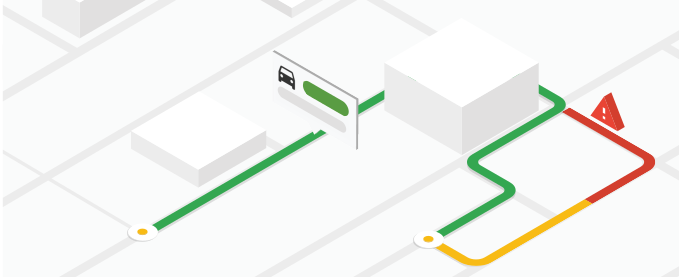
Directions API を使用する理由
Directions API を使用すると、公共交通機関、車、徒歩、自転車など、さまざまな移動手段の経路を取得できます。
Directions API でできること
Directions API を使用すると、次の詳細情報を含む、地点間のルートを計算できます。
- 公共交通機関、車、徒歩、自転車など、複数の移動手段のルート。
- 一連の地点を使用した複数の要素で構成されるルート。
- 出発地、目的地、経由地は、テキスト文字列(「シカゴ、イリノイ」、「ダーウィン、NT、オーストラリア」など)、プレイス ID、緯度/経度座標など、複数の方法で指定できます。
Directions API の仕組み
Directions API は、ルートを計算する際に最も効率的なルートを返します。このプロダクトでは、最も効率的なルートを決定する際に、次の旅行要素を考慮します。
- 移動時間(プライマリ)
- 距離
- 巻数
次のリクエスト例は、オンタリオ州トロントからケベック州モントリオールまでの運転ルートを JSON 形式で返します。
https://maps.googleapis.com/maps/api/directions/json ?destination=Montreal &origin=Toronto &key=YOUR_API_KEY
リソース
次の表に、Directions API で利用可能なリソースと、返されるデータをまとめます。
| データ リソース | 返されたデータ | 戻り値の形式 |
|---|---|---|
| ルート
出発地と目的地をプレイス ID、住所、または緯度と経度の座標の形式で指定します。詳しくは、必須パラメータをご覧ください。 |
ルート、レッグ、ステップに分割された詳細なルート。詳しくは、ルートのレスポンスをご覧ください。 |
|
Directions API の使用方法
| 1 | セットアップする。 | Google Cloud プロジェクトを設定するから始め、その後の設定手順を完了します。 |
| 2 | デモを試す | API キーとクラウド プロジェクトを取得したら、ルート検索デモを無料で試すことができます。Directions API のデモをご覧ください。 |
| 3 | リクエストを構築する | リクエストの例を参照して、移動手段、経由地、ルートの制限など、指定できるオプションについて学びます。経路の例をご覧ください。 |
| 4 | レスポンスの基本を理解する | アプリでルート案内データを使用する準備として、データ レスポンスを確認します。詳しくは、ルート案内レスポンスをご覧ください。 |
| 5 | 方向データを独自のアプリに組み込む | このデータを使用して、移動距離と所要時間を計算できます。 |
利用可能なクライアント ライブラリ
次のいずれかのクライアント ライブラリを使用して、選択した言語でこの API を呼び出します。
- Google マップ サービス向け Java クライアント
- Google マップ サービス向け Python クライアント
- Google マップ サービス向け Go クライアント
- Google マップ サービス向け Node.js クライアント
Google マップ サービス向けの Java クライアント、Python クライアント、Go クライアント、Node.js クライアントは、コミュニティがサポートするクライアント ライブラリであり、Apache 2.0 ライセンスの下でオープンソース化されています。GitHub からダウンロードできます。インストール手順とサンプルコードも GitHub で確認できます。
次のステップ
- Directions API の使用を開始する: スタートガイドに移動します。
- ルート リクエストの作成を開始する: ルートを取得するに移動します。
- ベスト プラクティスに従う: ウェブ サービスのベスト プラクティスに移動します。

